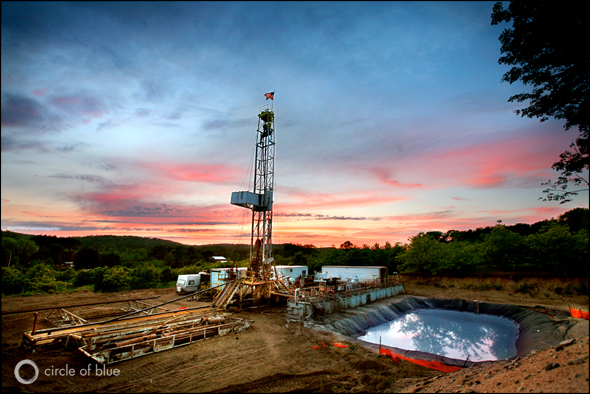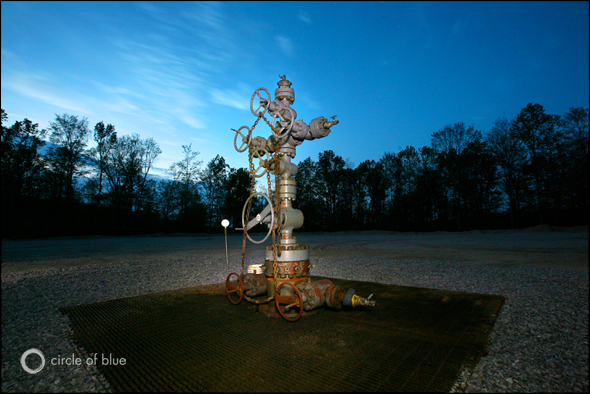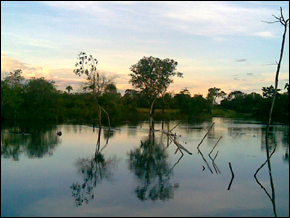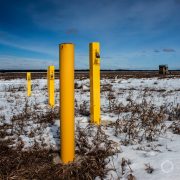Michigan’s New Natural Gas Rush: Energy and Water in Play
One natural gas gusher plus a record mineral lease sale could mean a big new play for energy producers and horizontal hydraulic fracturing in Michigan.

By Keith Schneider and Molly Ramsey
Circle of Blue
The aptly named Pioneer natural gas well, near Lake City in Missaukee County’s Pioneer Township, is a stack of gauges and metal piping that rises about 7 feet from a bed of crushed stone at the center of a five-acre clearing surrounded by Michigan hardwoods.
The only sound in the clearing is of songbirds hidden in the trees. The sole scent from the straight-as-a-gun-barrel well–drilled and tested last year–is the smell of money, and potentially of trouble.
Earlier this year the Pioneer well’s Canadian owner, the Calgary-based Encana Corporation, announced that during its first 30 days the well, drilled nearly two miles deep into a rock formation known as the Collingwood Shale, produced an average of 2.5 million cubic feet of gas a day. That made it, for a time, the most prolific single source of natural gas in Michigan. Production has since dropped back to 800,000 cubic feet per day, said state officials, though that is still a prodigious amount for a Michigan gas well.
“The industry’s response to the first well drilled to test this formation has been overwhelming,” said Tom Wellman, Manager of the Mineral and Land Management Section of the Michigan Department of Natural Resources and Environment.
A Gas Frenzy
How overwhelming? In early May the natural gas industry saluted the import of those numbers by spending $178 million at a lease sale of nearly 120,000 acres of state-owned minerals in 22 Michigan counties. That was more than seven times the previous record for a state lease sale, and nearly equal to the $190 million Michigan has earned, in total, since it began auctioning oil and gas leases in 1929. In October, Michigan is poised to auction mineral leases on 500,000 more acres, and the natural gas industry is poised, say executives, to spend a lot of money again.
Michigan’s leasing frenzy, touched off by the promising results from a single Missaukee County well, is part of a global rush to tap the Earth’s deep gas-bearing shales for a fuel that burns much cleaner than coal or oil. Spurred by advancing technology, developers penetrate geologic layers miles beneath the surface, and then pump water mixed with chemicals into the space at such high pressure that the rock fractures, releasing the gas.

Natural gas production in the United States is climbing as producers develop the deep shales in the Northeast, Texas, the Rocky Mountain states and now in Michigan. A two-year study by the Massachusetts Institute of Technology estimated that shale gas reserves in the United States can provide 92 years of energy based on current natural gas consumption rates in the country.
Water Needed Big Time
But production practices, particularly the use of millions of gallons of water, and thousands of pounds of chemicals used in the “hydrofracking” process, have stirred concerns about water contamination and supply.
Encana Corporation, which said in May that it had gained mineral leases to 250,000 acres in Michigan, was fined $370,000 in 2006 by the Colorado Oil and Gas Conservation Commission for flawed drilling practices that residents say caused methane and benzene contamination of Divide Creek in Colorado. Alan Boras, the company’s spokesman, said in an interview with Circle of Blue that the leak was “a rare circumstance” caused by flaws in the cement that holds the well casing in place.
“Within less than a week of being alerted, the problem was rectified,” Boras said.
Meanwhile New York has instituted a moratorium on shale gas development pending research by state authorities on the risk to water resources and public health. Communities in Wyoming and Pennsylvania have reported incidences of water contamination and methane mixed with drinking water in regions where shale gas development is occurring. The U.S. Environmental Protection Agency is completing a study of the risks of fracking.
Two years ago, in a study that has been criticized for political interference by the energy industry, the EPA conducted its first assessment of fracking, calling it safe and exempting drillers from water quality standards under the Safe Drinking Water Act.
Authorities in Michigan said in interviews that they are aware of the reports of problems involved in hydrofracking the deep shales. They said that the state is well-prepared to deal with the Collingwood development and the potential consequences it will have on the land, public health and Michigan’s fresh water reserves. Hal Fitch, the director of the Geological Survey Office, a unit of the state Department of Natural Resources and Environment, explained in an interview that Michigan has some of the toughest regulations in the country for overseeing oil and gas development, and that his office is well-staffed to enforce them.
Michigan Prepares
Fitch said the state is close to issuing new permit conditions that space the Collingwood wells at least a mile apart, which will reduce the number of well pads cut into the forest. But he acknowledged that each of the well pads will encompass five acres or more–five times larger than the typical natural gas and oil well pad.
He also acknowledged that because completing each of the Collingwood wells involves using millions of gallons of water to fracture the shale and open spaces for the gas to flow, the state may need to better understand the risks.

“There is a concern about the volume of water used,” said Fitch. ”While drilling and use of water is a one time deal for each site, it requires a lot of water. DNRE looks at the effect of water withdrawal on immediate surroundings, if it’s near a wetland or lake or adjacent public water supplies.”
Fitch added that state regulators make sure the activity is not depleting the aquifer at that site. But they do not look at cumulative effects of water withdrawals, the watershed-scale effects of withdrawals.
Big Play State
Northern Michigan is no stranger to big plays in oil and gas development. In the 1970s energy producers drilled thousands of wells into the Niagaran formation 5,000 feet below the surface along a narrow band that extended from Manistee County along the coast of Lake Michigan inland through Montmorency County. It was the largest oil and gas drilling zone on the continent until development opened on Alaska’s North Slope. In the 1990s, developers drilled thousands more wells in the Antrim Shale formation that were about 1,000 to 1,200 feet deep. The companies built an infrastructure of 9,700 well pads, thousands of miles of pipeline and roads, hundreds of compressing stations, and a number of big processing plants that produced considerable damage to streams and forests, but also yielded billions of dollars worth of natural gas.
Pioneer, the township where the well is located, is part of a rural farmland landscape known for its corn, dairy livestock, and Christmas tree farms, as well as a recreational inland lake popular with fishers and boaters in Lake City. The massive hydraulic fracturing of the Pioneer well required 5.5 million gallons of water. Some of the water was supplied by a freshwater aquifer at the site, while another portion was hauled to the site by trucks, said Joel Fox, a representative for Petoskey Exploration, Inc., the company that organized the drilling of the well for Encana, which they evenutally contracted out to Superior Gas.
The Collingwood Shale could be the source of Michigan’s third major hydrocarbon development era of the last 40 years, according to Encana. The company, Canada’s largest natural gas producer, spent an estimated $7 million to $9 million to drill and hydrofrack the well, making it among the most expensive wells ever developed in the state. It bored a hole nearly 10,000 feet deep into the Earth: one of the deepest ever drilled in Michigan.
“It’s too early to know the economic potential of this new Collingwood Shale play, but we plan to drill additional exploration wells this year that will help determine the play’s ultimate potential,” said Randy Eresman, Encana’s president and chief executive in a statement.
Keith Schneider is senior editor and producer at Circle of Blue. Molly Ramsey is a Circle of Blue reporter. Contact Keith Schneider
Photos by Heather Rousseau, a reporter and photojournalist for Circle of Blue. Reach her at circleofblue.org/contact.

Circle of Blue’s senior editor and chief correspondent based in Traverse City, Michigan. He has reported on the contest for energy, food, and water in the era of climate change from six continents. Contact
Keith Schneider








Fracturing is a danger to Michigan’s watershed.
Those interested in joining Don’t Frack Michigan and our campaign to ban horizontal hydrofracking in MIchigan, please contact me at luannekozma@gmail.com.
Take a look at what Encana is doing in northern British Columbia at the oil sands deposit and you won’t let them work within 100 miles of your property. I don’t remember the title but it’s detailed in a “Nature of Things” episode on the BBC. It would also be a good idea to watch the HBO documentary “Gasland” which shows the direct effects of fracturing. Spread the word, our water is more important than money.
i called bp and toyko power and they said it was safe
Given the economic state that Michigan is in, this sounds too good to be true. Imagine how many businesses would have to hire more staff? How many jobs would be created directly in the industry? I may be wrong, but I believe the oil and gas industry pays pretty well! Yes. Watch ‘Gasland’. See how propaganda is spread. If my neighbors became wealthy and I did not, I would be happy for them, not jealous! As far as the water table, check into what Keystone state of Pennsylvania has found in the areas of the Marcellus formation. Not a whole lot of contamination! Very little. So little that PA is a major hot spot. DEQ is tight, which they should be. Precautions are taken, spills and other forms of environmental mishaps are to a minimum. Drill the heck out of Michigan! Let’s get some of the economy back!
booms are not economies. economies are economies. practical and proper tax equality, governance, distribution, property protections and environmental quality are what make a place desirable to live in. not methane. natural gas is a resource but a dangerous one with a not unjustified soiled reputation. It’s extraction is going to happen, but it should be done under incredibly tight regulation to protect the delicate balance of what really makes Michigan a nice place to live. The sanctity of property rights must be preserved. Methane seepage and water contamination are ridiculously bad externalities and must be prevented where possible and excessively compensated where not. Compensation for these needs to be in the hundreds of millions of dollars to be effective deterrents. @Chris: “Drill the heck out of Michigan” – ? If it stimulates the economy so well, I believe you could get some good real estate deals in PA, CO and Idaho now.
take a look at tar sands in Canada http://www.youtube.com/watch?v=YkwoRivP17A
brief message http://www.youtube.com/watch?v=_5aXo87N6nU
how encana buries toxic waste of brine: